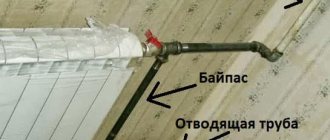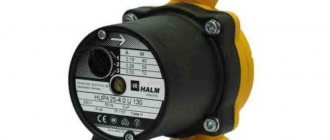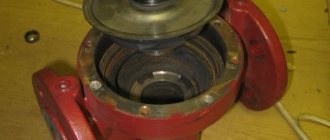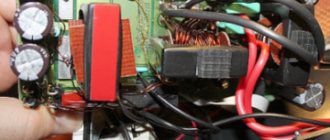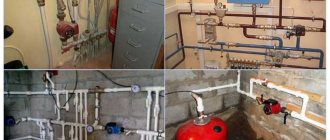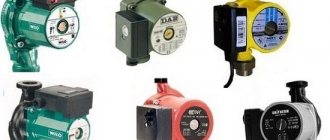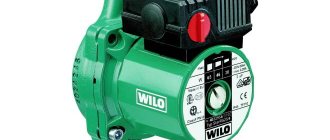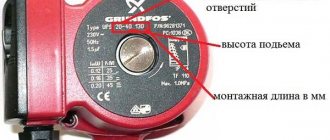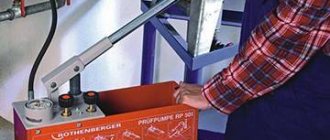Battery tying
If the installation of the system is carried out independently, then you need to know all the requirements that apply to this or that element. This also applies to the bypass. It is often installed in places where radiators are mounted. But why do you need a bypass in a heating system? This issue needs to be looked at more carefully.
Radiators are tied according to a simple pattern
Why is it needed?
Previously, single-pipe heating was used in the construction and improvement of houses. This greatly simplified the work and also reduced costs. In this case, two collectors were installed in the elevator unit, which were responsible for supplying and processing the coolant. Further heating was developed according to different schemes:
- Top feed. There was a pipe running from the collector to the top floor. The coolant was supplied upward through this riser. After that, it went down, passing through all the radiators.
- Bottom feed. In this case, the coolant begins to flow into the radiator when it is raised up. This series connection of devices has some disadvantages.
In both the first and second cases, the connection is made in series. This means that if a problem occurs on some equipment, you will have to turn off the entire system. To circumvent this problem, special jumper pipes were included in the system. So, if necessary, the radiator is disconnected from the system using taps without disturbing its operation. This makes it possible to easily repair the battery.
The jumper is installed closer to the battery
This is not the only reason for using a jumper in heating. The room is heated using radiators. If there is a bypass with valves, apartment owners have the opportunity to independently adjust the coolant supply. Thus, controlling the temperature in the house is not difficult.
The dressing tube has different shapes
Bypass installation
To carry out heating installation, you must have certain knowledge and skills. This takes into account the method of pipeline assembly. For this purpose, threaded and fitting connections are used, as well as pipe soldering. Having these skills will make the job easier. It is worth considering some rules and recommendations from experts:
- There should be no valves between the rack and the bypass. Otherwise, the coolant circulation may be disrupted.
- On the vertical riser pipe, the jumper is mounted in close proximity to the battery. In this case, space must be provided for installing shut-off valves. It is mounted on both sides of the radiator.
- Do not install valves on the bypass unless necessary. If you install taps on the jumper, the circuit will become unbalanced. In an autonomous system of a private house, this in turn allows you to redirect the flow. In a multi-story building, this option is ineffective and is a violation of standards.
- The size of the pipes is important. The diameter of the insert is two sizes smaller than the section of the stand. The pipes that go to the radiators are made one size smaller. In the horizontal scheme, the size ratio is somewhat different.
Compliance with the dimensions of pipes and pipes will ensure normal operation of the system, in accordance with all the laws of hydraulics. As for installation, its features directly depend on the type of material used. If we are talking about a metal pipeline, then it is enough to simply weld the jumper and install the taps.
Installation is carried out in different ways
The use of polypropylene, as well as metal-plastic, requires the use of special fittings. You can build a bypass yourself from a pipe of the required size or purchase a ready-made part.
The pump is often installed on a jumper
Types of jumpers
There are three types of bypass, they can be distinguished by the mechanisms responsible for the shut-off function, the list looks like this:
- Mechanical action is used for control.
- Non-adjustable, static models.
- Elements equipped with automation.
Each of the presented types has its own design features, and the methods of application are also somewhat different. To understand in detail all the small points and understand what kind of bypass is needed, it is worth considering each design option separately.
With manual regulation
To adjust in this situation, a ball valve is used; this type of bypass has gained wide popularity because at the moment of opening, the permeability of the pipe fully complies with generally accepted requirements, and if necessary, the path can be cut off without problems.
The absence of hydraulic resistance has a beneficial effect on the functionality of the line, and with the help of an additional element it will be possible to regulate the fluid pressure.
Experts advise paying attention to one nuance: the valve on the bypass may become stuck over time; to avoid such negative consequences, it is necessary to turn it periodically, preventing the structure from being down.
Often, the type of connection that will later regulate the manual bypass is used to connect batteries in a single-pipe circuit or when piping a circular pump.
Auto
Known types include:
- Valve.
- Injection.
Such units can be seen in a gravity-type pipeline, since for good heating operation it is not necessary to install equipment responsible for the forced movement of the coolant. The valve type of device serves to prevent the unimpeded movement of liquid in the opposite direction.
Injection bypass
Among the disadvantages, it is worth highlighting the increased sensitivity of the main element to the purity of water; such unpleasant contaminants as the following can cause problems in the process of a circulation pump with a bypass:
- Scale.
- Rust.
- Metal shavings.
- Scale.
The injection model operates on the principle of a hydraulic elevator; at the moment the pumping equipment starts, some part of the diffuser of the inlet pipe is filled with liquid, where it is accelerated. At the moment of discharge, due to the narrowing of the pipe, the coolant from the bypass is drawn in and directed at a different speed due to the transfer of kinetic energy.
When the pump is turned off, the line can work fruitfully in a natural mode, water calmly passes through the bypass, such structures are much less likely to become clogged, this is due to the lack of precisely fitted parts.
Unregulated
There is no additional equipment on this component of the heating system; it looks like a regular bypass pipe. The mode becomes uncontrollable, liquid passes through the gap in the line constantly; similar elements were provided for connecting radiators.
In a scheme with vertical installation of a bypass in a heating system, it is necessary to take into account some nuances; the diameter of the bypass cross-section should be slightly smaller than the circuit pipe. The horizontal type of insertion will require compliance with other requirements, because hot water will tend to rise, the jumper must be created with the same diameter as the main, and the pipe suitable for the battery must have a smaller cross-section.
Errors often encountered during self-installation
Often, home craftsmen who decide to install new aluminum radiators themselves instead of old cast iron ones make two common mistakes:
- they equip the direct bypass section with a ball valve in an attempt to direct all the heated water into the battery;
- assemble a mixing structure, adding a three-way valve to independently regulate heat transfer.
The second example, at a stretch, can be called acceptable if we are talking about individual heating; here the homeowner can individually control the output of the heating unit. In standard apartment buildings, neighbors can be vulnerable if one person unbalances the system by taking away more heat.
Finally, if a bypass is added to the design of a heated towel rail, it is intended only for the convenience of replacing and servicing this heater. The element in question does not affect heat transfer, since the pressure and speed of movement of the medium in the water supply here change to an insignificant extent.
Types of bypasses
There are several types of bypasses for use in heating systems.
Unregulated
It is made in the form of a bypass jumper. There is no shut-off and control valve (faucet or check valve) on the jumper.
Operating principle
- Part of the hot HP passing through the bypass is mixed with the flow at the outlet of the battery and increases the temperature of the HP entering the input of the next battery.
- If the heating device fails, the HP flow bypasses the battery, maintaining circulation.
Peculiarities
- When installing vertically, the diameter of the bypass is one step smaller than the diameter of the supply pipes.
- With horizontal wiring, the diameter of the circuit coincides with the supply pipe, and the diameter of the branches up the battery is one step smaller (the heated HP tends upward).
- Install as close to the battery as possible (next to the shut-off valves).
Manually controlled: what is it?
To manually regulate the flow of the HP through the bypass, either a ball valve is installed on it to shut off, or a three-way valve is installed at the intersection of the bypass and the supply pipe to the radiator.
Operating principle
The three-way valve has three positions:
- closes the bypass and directs the entire HP flow to the radiator;
- closes the supply to the radiator and opens the bypass for the HP flow (position for repairing or replacing the radiator);
- opens both paths for the transformer: to the battery and along the circuit.
Peculiarities
- A valve on the bypass next to the battery is usually installed to close the jumper when the radiator is not heating well. But such a solution is technically illiterate - the flow through the bypass is approximately equal to the flow through one section of the radiator, so a significant increase in the temperature of the battery will not occur.
- In a private house, a ball valve is installed in parallel with the central pump on the return pipe. The valve is closed when the pump is running, and opens manually when the pump fails or when it is replaced to restore circulation.
Attention! In an apartment building with a single-pipe system, it is prohibited to install a valve on the radiator bypass. It can lead to disruption of circulation and reduced temperature of the coolant entering neighboring apartments
Automatic, like working with a pump
Installed in parallel with the central heating unit. A check valve is mounted on the shunt pipe to automatically restore circulation through the bypass when the central pump is stopped.
Operating principle
A bypass with a differential (ball) valve is installed in parallel with the central heating unit on a vertical coolant supply pipe from the boiler.
When the pump is operating, part of the flow presses the rubber ball against the funnel and closes the passage of the HP through the shunt pipeline.
When the pump is turned off, the ball rises under the pressure of the HP flow through the supply pipe and opens the passage for the HP through the bypass.
A bypass with a petal check valve is installed parallel to the pump on a horizontal return pipe (in a gravity system). The valve shutter (petal) is pressed against the seal under the action of the flow from the pump, closing the bypass. When the pump stops, the petal moves away from the seal (opens) under the influence of return hydraulic pressure, restoring circulation.
Important! It is necessary to periodically check the operation of the check valve so that it does not become clogged with deposits and dirt. The check valve is usually mounted on the main pipe (supply or return)
Bends from the main pipe to the central pump are made two sizes smaller in diameter
The check valve is usually mounted on the main pipe (supply or return). The bends from the main pipe to the central pump are made two sizes smaller in diameter.
General information about the device
For our readers who like to make things with their own hands, it will be extremely useful to learn more about it
We will try to avoid complex technical terms so that the features of this important structural element are clear to most
A bypass is a jumper between the supply and return, made in the form of a piece of pipe. It is usually used for a heating radiator, and its diameter should be one size smaller than the supply diameter. Most often you can find 1/2″ pipes. Today, such a device has become somewhat different, although its original capabilities have not been forgotten.
Modern heating bypass assembly
Application
Below we consider the main options for using the device:
| Coolant adjustment |
|
| Without electricity | The installation of the device is especially important for modern heating circuits, where a circulation pump is provided. It answers the most frequently asked question by consumers in retail chains: “How will the system operate when the power goes out?” For many years, the use of standard floor-standing boilers did not include their dependence on electricity. However, the use of a circulation pump heating system made the units energy-dependent. When the electricity goes out, the instructions recommend turning off the coolant supply to the pump and opening the valve on the central main pipe. If you equip the device with a valve, this work will be performed automatically. All this must be done in order to transfer the system to natural circulation mode. |
What bypasses are used for heating and their connection diagram
Installation of devices on the bypass must be done towards the coolant, observing the following sequence:
- filter - serves to retain large and small particles that may appear in an open heating system, entering it from the water supply. The price of the part is low, but it does a very necessary job;
- check valve - ensures the flow of coolant in only one direction. When installing it, you must be guided by the arrow on the body, which indicates the direction of flow;
- circulation pump - necessary for forced pumping of coolant through the heating system.
Heating bypass with shut-off valves
We recommend installing the element horizontally. Then air will not accumulate in the system, i.e. she will not “get airy.”
Use in single-pipe heating
This system is morally outdated, but it is still quite common in Soviet-built houses. Sometimes such heating works extremely efficiently, which is why apartments become unbearably hot in winter.
Bypass in single-pipe heating of a private house
In such a situation, installing a bypass can help.
The process is simple, however, when carrying out it, certain conditions must be met:
- The bypass must be placed at the maximum distance from the vertical section of the pipe. It would be more correct to say as close to the heating radiator as possible.
- The heating bypass pipe can be made directly at the installation site from the pipe itself, a tee, which are connected by welding.
- Install a thermostat or control valve between the bypass and the inlet of the heating battery. This will allow you to control the temperature in your home.”
Bypass pipe and energy consumption
Installing the device will reduce energy costs. When compared with the operation of a heating system where a closing section and a conventional flow section are installed, in the first case the volume of coolant supplied to the radiator will decrease by a third. In this case, the heat transfer of the heating device will be reduced by approximately 10%.
Self-installation of bypass in the heating system
These changes in practice will not look drastic when the system is really characterized by an excess of heat. With the correct selection of radiator sizes, there is usually a certain efficiency margin of about 10-15%, which completely covers the reduction in heat transfer.
Operating principle of the bypass valve
If an unusual situation occurs, a power outage or a pump breakdown, the pressure stops and the valve automatically closes the jumper, allowing water to flow naturally. This allows the heating system to be fully automated. The disadvantage of automatic bypass is sensitivity to water contamination and small contaminants. Before installation, it is recommended to clean the water supply system of the AED to remove deposits and rust in pipes and radiators.
Before starting work, you need to decide on the material of the water supply system. For polypropylene pipes, dismountable connections are used, and first the pump block is assembled along with the bypass. The branch is connected using tees mounted in the main pipe. For the steel version, first the pipes are soldered in, then the valve on the bypass. The bypass system is installed towards the coolant and must be assembled in a certain sequence.
Assembly diagram:
- Filter;
- Check valve;
- Forced action pump.
The diameter of the bypass line passage must be equal to the return diameter. Experts recommend that all taps be equipped with dismountable fittings during installation. In this case, various situations will be eliminated during the repair.
Before starting installation work on installing the pump, it is necessary to drain the coolant from the system. The entire structure is oriented so that the outlet pipelines are vertical or horizontal, depending on the stroke of the pipe.
How the bypass line works:
- They assemble a section of the bypass that will be located parallel to the highway;
- A section equal to the length of the bypass is cut off from the return;
- Tees are installed at the ends of the line;
- A section with shut-off valves or valve is mounted between them;
- The assembled section of the bypass is connected to the main line with pipes of equal length.
During installation, it is necessary to leave space for subsequent dismantling of the pump and other elements. It is necessary to carry out the installation correctly, making sure that the arrow on the housing coincides with the coolant current.
Recommendations for bypass installation
When installing a bypass, certain rules must be observed:
- The bypass diameter should be one caliber smaller than the main pipe. Otherwise, according to the laws of hydraulics, all the coolant will flow along the path of least resistance past the heating radiator. For example, if the liner has a ∅ ¾ inch diameter, then for the bypass you need to use a ∅ ½ inch diameter.
- The bypass must be installed as close as possible to the heating radiator and, accordingly, further from the riser.
- At the design stage, decide how automated the heating radiator control process should be. Accordingly, use shut-off valves or thermostats in the future.
- It should be taken into account that after installing a bypass, the radiator will receive 30-35% less coolant, and heat transfer will decrease by 10-15%. Taking this into account, you need to select the size of the new radiator.
- It is not recommended to install a shut-off valve on the bypass itself. This is especially true in apartment buildings, when, through carelessness, by turning off this tap and the taps on the radiator, you stop the flow of coolant in the entire system.
Blitz tips
- Installing a piping on the riser is unacceptable; it should be placed near the heat exchanger at a distance of at least 2/3 of the pipe length. At the same time, it is also not recommended to install the module very close to the radiator; this can lead to overheating and changes in current parameters, which will disrupt the operation of the entire system.
- Installing a valve on a valveless bypass in apartment buildings is prohibited. Despite certain conveniences for the user, this is a gross violation of SNiP, since the installation of auxiliary elements on risers can lead to a violation of the calculated flow of thermal mass and disrupt its proper circulation.
- When making a bypass module yourself, you should use high-quality components. During the welding process, the seams must be even and smooth.
- The installation of the bypass module must be carried out in such a way that in case of repair, parts that wear out quickly can be dismantled using an adjustable wrench.
Bypass in the heating system - options for proper installation. Overview of the main functions of a bypass in a heating system, what is it - we answer with details, installation of a bypass in a heating system, bypass for a circulation pump, on a heating radiator, in heating. Bypass in a heating system, what is it - the theory of its necessity and the practice of installation. Bypass in a heating system: use and installation diagrams. Bypass in a heating system - options for correct installation. Overview of the main functions What is a bypass in the heating system of an individual house
How to install the system
It is advisable to install bypasses simultaneously with the installation of the heating system. Sometimes such a device needs to be installed in an existing heating system. The most preferable installation season in the latter case is the warm seasons, since during such periods the heating system is not operated. It should be remembered that when carrying out installation work, the liquid must be drained from the pipeline.
It should be noted that the work itself and the complexity of its implementation are directly dependent on the materials from which the pipeline is made, as well as the heating circuit itself. The simplest work will be with metal-plastic. And polypropylene or metal requires the use of welding devices. That is, you won’t be able to install it yourself; you will need the help of specialists.
When installing yourself, you need to remember that first of all attention is paid to the section of the bypass route, which is installed parallel to the return
It is important not to forget to install the shut-off valves as well. You also need to be careful about the sides of the pipe - it’s better not to confuse them.
You also need to be careful about the sides of the pipe - it’s better not to confuse them.
You also need to be careful about the sides of the pipe - it’s better not to confuse them.
So, the bypass is an important and useful device that can help in many situations, so it is better not to neglect its installation
Bypass and circulation pump
Autonomous heating is the optimal solution for a country house. Often the system is equipped with a pump that provides forced supply of coolant. This allows you to increase the efficiency of its work. Despite the fact that the pump consumes electricity, its installation is completely justified.
The disadvantage of the pump is that it is dependent on an electrical source. As a result of the lack of electricity, the unit stops working and thereby interferes with the normal operation of communication
To prevent such a problem from occurring, experts recommend paying attention to bypasses for the circulation pump
In this case, the pump is connected to the system via a bypass. In other words, it is installed on the jumper itself. Valves are installed on both sides. At the same time, a tap is installed on the line between the inlet and outlet of the jumper. In normal mode, water flows through the bypass. If there is a loss of electricity, then the taps on it are closed, and on the main line they are opened. The coolant is redirected straight, bypassing the bypass.
Taps are installed on the jumper with the pump
Kinds
Bypass valves are divided into several types:
- Classic bypass , when air is sent back to the intake manifold. It has two main advantages. First, the car operates quietly, without “squeaking” sounds, which made such a system more popular among automakers and the most widespread. Secondly, the bypass allows you to avoid overfilling the engine with excess fuel. The supply of fuel to the combustion chamber is regulated by the volume of air, which was determined by the flow meter before entering the turbine. If the air is simply vented into the atmosphere, the engine may simply stall when the gas is released. Therefore, such valves are always used in cars with mass air flow sensors. The disadvantage of such a bypass is that it cannot cope with the increase in turbine power and does not have time to remove air. Therefore, such valves are installed on most production cars equipped with standard turbines, but are not used in “charged” cars.
- Blow-off valve (pressure relief valve) - releases air into the atmosphere. Most often installed on sports and tuned cars. Used in conjunction with an absolute air pressure sensor to measure the volume of air being bleed. Some specialized manufacturers offer blow-off valves with customized sound effects for those who like to customize their car.
- Hybrid versions. Some automakers (for example, Mitsubishi) offer hybrid valve designs where in normal operation they act as a bypass, but under severe overpressure they can bleed air into the atmosphere as a blow-off.
Step-by-step instructions for installing a bypass
It is advisable that the heating system, including bypasses, be installed by specialists who can correctly calculate everything, carry out installation, commissioning and pressure testing in accordance with the rules and regulations provided for in this area of construction. However, if you think that you can handle everything yourself and are 100% confident in your strength, then you should read the installation instructions.
The most important thing at the initial stage is to make a competent calculation of the bypass. Then you will need to purchase ready-made structures or make them yourself. For those who are making a heating system for the first time, it is better to use the first option. This will reduce the likelihood of error to almost zero, since the finished parts are already designed for a particular pipe and you won’t have to rack your brains. Once you have decided on the type of equipment and purchased everything you need, you can begin installation.
The most important thing to remember is that the bypass is never installed on the riser. It should be shifted closer to the heating radiator by at least 2/3 of the length of the pipe. There is also no need to make a bypass close to the battery, as this will cause it to overheat and change the flow parameters, which will destabilize the entire system.
You cannot install a valve or gate valve on a valveless bypass. For all its convenience, this solution violates the rules for using heating in apartment buildings, since it is prohibited to install additional elements on the risers that could change or disrupt the flow of liquid. After all, this is a complex system in which even the slightest changes in parameters can disrupt its performance. The narrowing of the bypass diameter relative to the rest of the pipeline must be calculated correctly, so that there is no fear of a decrease in the heating capacity of the radiators.
If your heating system is installed from polypropylene pipes, then you should use a special soldering iron for installation. When inserting a bypass into an existing heating system, it is necessary to cut out sections of the pipe with the devices, install tees on the cuts and use them to assemble the system with a bypass pipe of a smaller diameter. After completing the installation of the bypass, connect the device, which is bypassed with the help of it, and test them together. Having created a pressure in the system that is 1.5 times higher than the calculated one, you need to wait some time, observing the pipeline. If no leaks or sweating are found anywhere, then the work performed can be considered successful.
If you are installing any complex mixing units or filter elements on a water supply system, then you should use the instructions provided by the manufacturer of this equipment
In any case, the installation of the bypass must be done with great care, since an error can lead to deterioration of the system and the need to redo everything
It is important that there are some supports or pipe fittings directly next to the bypass you install. If this does not happen, the heated pipe may bend, which will radically ruin the entire appearance.
The very large diameter of the bypass pipe will ensure a constant flow of coolant through it, and not through the battery, which can completely disrupt the entire heating system. Well, an important factor is the aesthetic component. Try to install the pipes neatly and evenly, placing all elements at right angles. This will ensure a beautiful and harmonious appearance of the entire heating system, and it can be combined with any interior, even without special camouflage.
In general, constructing a bypass with your own hands is quite accessible to most people; you just need to read the instructions a little in advance and take care of the order of the work. As a result, it is worth noting that such an elementary and inconspicuous element of the heating system plays a very important role in the proper functioning of the heating of the entire house. If the calculation, selection and installation are carried out correctly, using the advice of specialists, then the further use of all heating or plumbing equipment will be as easy and relaxed as it should be. Real savings when using loop heating systems can be about 10% of all energy costs for these purposes.
Bypass in the circulation pump assembly
There is probably no need to prove that an autonomous heating system for a private house, operating on the principle of forced circulation of coolant, is more efficient and controllable. Installing a pump quickly pays off both in terms of optimal heat distribution throughout the premises and in economical operation, and this even despite the fact that the pump itself is a consumer of energy. Even those owners whose systems were once assembled were designed for natural, gravitational circulation, now do not refuse the additional installation of a pumping unit.
But here’s the problem: in a number of areas, power outages are not an unusual occurrence. Well, the heating system, tied to a circulation pump, willy-nilly becomes energy-dependent. It’s good if the issue of some alternative power supply for this case is thought out - from an uninterruptible power supply or your own generator. , although this will only help for a short period. This means that it is necessary to plan the heating system so that in such extreme situations it can switch to operation on the principle of natural circulation. And the bypass installed on the pump unit helps with this.
Pumping units with bypass are different in design, but completely identical in principle of operation - it is possible to switch from forced to natural circulation
Such a unit can operate in manual mode - in the absence of power, the owners only need to switch the taps, redirecting the coolant flow not through the bypass with the pump, but directly through the main pipe. In other assemblies, valve devices are used - there the flow will be redirected automatically. Another option is an injection circuit, without a tap or valve, but, to be honest, it is not particularly praised, and it is still advised to turn to the “classics”.
In this publication we will not dwell on the pumping unit with a bypass. Not at all because this issue is not important. Rather, on the contrary, a separate publication is devoted to the problems of choosing and correctly installing a circulation pump, from carrying out the necessary calculations to step-by-step instructions for self-installation.
Prices for different types of circulation pumps
circulation pump
You might be interested
Stoves and heating systems Gas heaters for a dacha with a cylinder: which one to choose and calculation of the required power to heat the room Having a dacha or outside the city is the longed-for dream of many residents of modern... Evgeniy Afanasyev 36516 1
Stoves and heating systems How to choose a stove for a cauldron - rating of the best models of 2022 The taste of real pilaf probably does not leave anyone indifferent. And that’s why... Evgeny Afanasyev 959 0
Furnaces and heating systems Which metal-plastic pipes to choose for heating: types of pipes and which ones are better to choose Without any exaggeration, it can be said that the appearance of metal-plastic pipes in its... Evgeniy Afanasyev 2372 0
Stoves and heating systems Rating of heat pumps for heating a home: recommendations for choosing Against the backdrop of a constant rise in energy prices, more and more homeowners are turning their... Evgeniy Afanasyev 558 0
Stoves and heating systems Leningrad heating system: diagram and what critical mistakes should be avoided during installation When building any country house, the owner, one way or another, must face... Evgeniy Afanasyev 165250 0
Bypass in the boiler room
In boiler piping schemes, a bypass line is also necessary in 2 cases:
- as a bypass for a circulation pump;
- for organizing a small circulation circuit for a solid fuel boiler.
A pump installed on a bypass pipeline is found in heating systems quite often, sometimes even without special need. The fact is that a one-pipe or two-pipe heating system, originally designed with forced circulation, will never be able to function when the pump is turned off. It does not have large slopes and increased pipe diameters for this. But a bypass for the pump is precisely what is needed so that water can flow in a straight line while the pumping device is not working.
Another thing is a system adapted to the natural movement of water. It often happens that in order to increase efficiency, a pump is not simply built into it, but a bypass system with a check valve is installed in the direct line. This allows you to automatically switch to natural circulation in the event of a power outage, which is reflected in the diagram:
While the pump is running, it presses the valve on the reverse side with its pressure and does not allow flow to flow in a straight line. As soon as you turn off the power or turn off one of the taps, the pressure will disappear and the bypass valve will open a direct path for the coolant, convective movement of water will be restored. You can safely remove the pump or clean the sump; this will not disrupt the operation of the system, it will simply switch to a different mode.
Well, the last place to use the bypass is the small circulation circuit of a solid fuel boiler with a mixing unit. Here, a jumper connected to a three-way valve allows the heat generator to warm up to a temperature of 50 ºC in order to avoid the effects of low-temperature corrosion on the steel walls of the firebox. In this case, the bypass circuit looks like this:
The principle of operation is simple: the valve does not allow cold water from the system into the boiler until the coolant circulating through the bypass line heats up to the required temperature. Then the valve opens and lets cold water into the circuit, mixing it with hot water. Then condensation does not form on the walls of the firebox and corrosion does not occur.
Sometimes a bypass is still needed in the water supply system. For example, to remove a heated towel rail in the bathroom for repair, cleaning or replacement. Since it is connected to the hot water riser, its dismantling in an apartment building will create a lot of inconvenience. It’s easier to foresee this in advance and install a jumper with a tap when installing the heater.
Application in radiator piping
Schemes with a bypass line on radiators are used in both single-pipe and two-pipe CO systems. In a single-pipe heating system, a bypass is installed so that if the coolant circulation through the battery stops, the heating circuit continues to operate. In addition, another important function of this element is to transfer the same amount of thermal energy to all radiators located in the heating circuit.
In vertical circuits, a bypass jumper is installed between the supply and return pipes of the battery. The flow area of this element is, as a rule, one size (caliber) smaller than the supply pipeline.
In horizontal CO schemes, the main pipe itself is a bypass and has the same cross-section along the entire length of the circuit.
A bypass in a two-pipe heating system is used to regulate the temperature of the coolant. In centralized and autonomous heating systems, this element is used to make it possible to carry out preventive and repair work without disconnecting from the heating system or stopping the boiler equipment.
To redirect coolant from the radiator to the bypass, the following is used:
- Shut-off valves (ball valves).
- Three-way valve with thermostat.
Advice: if you plan to install a bypass pipeline for piping batteries in a house with centralized CO, then this can only be done by obtaining permission from the management company, whose representatives will shut off the riser to carry out the work.
The diagram (Fig. 1) shows a manual bypass in the heating system of a private house, which allows the system to operate open and closed, in forced or natural circulation mode, even during an emergency power outage. In fact, the bypass here in the diagram is a section of the return pipe with a shut-off valve, between the two connections of the circulation pump line.
The bypass in the heating system can work either only during startup, which allows you to quickly warm up all radiators at the same time, or on an ongoing basis. It is also installed in case of any reasons for poor natural heating circulation, for example: incorrect or unsuccessful installation of the system.
Check valve in heating
A check valve in heating can be installed on the bypass instead of a tap. The valve, when the circulation pump is turned on, is closed, and if there is a power outage, it automatically opens, which allows the system to switch to natural circulation. The inclusion of an automatic check valve in the bypass is controversial. If the check valve in the heating does not work properly due to mechanical inclusions of the coolant (scale, rust, etc.) getting into it, which is especially important with steel pipes and cast iron radiators, then it is impossible to check this visually, and the filter is in front of it can't bet.
Bypass installation
The bypass is installed near the boiler on the return line, where the coolant (water) has the lowest temperature. The installation location should not be too close to the boiler to prevent the pump from overheating. To prevent airing during filling of the heating system, the bypass structure is mounted in a horizontal plane.
For heating to operate with natural circulation, the tap must be open and the circulation pump must be turned off. When the heating system operates in forced circulation mode, the taps are open, the tap is closed and the pump is turned on.
Expert answers to questions
Most often, people who are not well versed in individual heating ask the question: is a bypass needed in a two-pipe heating system near the radiators? If we consider a single-pipe heating system, a jumper is usually installed in it to ensure the operability of the entire line in the event of a shutdown or malfunction of one of the heat exchange elements in the circuit, their uniform heating, and the need for a bypass is beyond doubt. In a two-pipe distribution, such problems do not arise by definition; each circuit is connected independently of the others, and all receive coolant at the same temperature.
The simplest jumper from a piece of pipe in a heating line performs many functions in a single-pipe wiring diagram - it maintains constant temperatures on all heat exchangers and uninterrupted functioning of the entire system, and ensures high maintainability of heating elements. The bypass pipe can also be found in underfloor heating systems and piping solid fuel heating boilers, where it increases the efficiency and reliability of the equipment.

